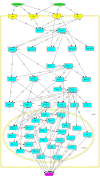Modeling of the MAPK machinery activation in response to various abiotic and biotic stresses in plants by a system biology approach
- PMID: 23847397
- PMCID: PMC3705613
- DOI: 10.6026/97320630009443
Modeling of the MAPK machinery activation in response to various abiotic and biotic stresses in plants by a system biology approach
Abstract
Mitogen-Activated Protein Kinases (MAPKs) cascade plays an important role in regulating plant growth and development, generating cellular responses to the extracellular stimuli. MAPKs cascade mainly consist of three sub-families i.e. mitogen-activated protein kinase kinase kinase (MAPKKK), mitogen-activated protein kinase kinase (MAPKK) and mitogen activated protein kinase (MAPK), several cascades of which are activated by various abiotic and biotic stresses. In this work we have modeled the holistic molecular mechanisms essential to MAPKs activation in response to several abiotic and biotic stresses through a system biology approach and performed its simulation studies. As extent of abiotic and biotic stresses goes on increasing, the process of cell division, cell growth and cell differentiation slow down in time dependent manner. The models developed depict the combinatorial and multicomponent signaling triggered in response to several abiotic and biotic factors. These models can be used to predict behavior of cells in event of various stresses depending on their time and exposure through activation of complex signaling cascades.
Keywords: Abiotic; Biotic; CellDesigner; MAPKs; Modeling; SBMLsqueezer; Simulation; System Biology.
Figures



References
LinkOut - more resources
Full Text Sources
Other Literature Sources
Molecular Biology Databases
Research Materials
